
Public Service Advertising for the Peace Corps - A Case Study
Recruiting
PEACE CORPS CASE HISTORY
PSA Program Overview
After nearly a ten year hiatus, Peace Corps began using public service advertising again as a strategic marketing and recruiting tool in early 1994. Historically, PSAs have been an important device for generating recruiting leads for Peace Corps and they have helped to communicate information about new development programs. Most importantly, PSAs have helped the Peace Corps build public awareness among key constituents. Their positioning line – “The Toughest Job You’ll Ever Love” became one of the most memorable theme lines in social issues marketing history.
During the seven years that Goodwill Communications has been distributing Peace Corps PSAs, they have received a total of 782,000 leads, which in turn resulted in 58,558 applications, 21,456 invitations to join the Peace Corps, and 18,028 Volunteers who actually joined. While there has been an active direct mail program and college recruiting efforts during this time, paid advertising was minimal, meaning that PSAs contributed to the lion’s share of recruiting leads.

PSA Leads/PSA Relationship
Since we have been involved with Peace Corps marketing, lead generation grew significantly for the first four years from 102,172 in 1994 to 151,137 in 1997. During each of these years, Peace Corps distributed two PSA campaigns per year. Then, in 1998 some interesting trends began to develop. Only one campaign was distributed in 1998 and in 1999. As we can see from the graph, leads also dropped from the high point in 1997 to 135,767 in 1999, a decrease of 11 percent.
Based on the analysis we did for the first two months of 2000 – the last time there was any PSA activity - as compared to the historical average, Peace Corps leads continued to decline. Our analysis indicates that on average, the Peace Corps generated 10,862 leads per month over the past six years when PSAs were being distributed compared to only 8,211 per month for the first two months of 2000 when they were not. This trend data suggests there is a direct correlation between lead generation and PSA activity.

Between 1994 and 2000, Peace Corps PSAs have generated just under $60 million in advertising equivalency exposure, based upon data provided by the media or the A.C. Nielsen electronic tracking system. Also, the Peace Corps now has a solid core of media outlets that are regular users of their PSA materials including 1,475 television and cable stations, 3,500 radio stations, and nearly 1,500 print media which have used Peace Corps PSAs.
Creative Strategy
Shift in Focus
The creative focus of the TV PSAs in the earlier years was on the international Peace Corps mission.
However, many U.S. media gatekeepers are more concerned about local issues and the domestic impact of the campaigns they air. Accordingly, after several waves of PSAs were distributed, we recommended that Peace Corps slightly shift its creative strategy from an international focus to the domestic benefits that are derived here at home from Peace Corps Volunteers’ work.

This slight re-positioning of Peace Corps creative strategy translated into significantly greater use of Peace Corps PSAs because local public service directors began to recognize the importance of the Peace Corps mission in light of its local impact. The “Value” TV PSA campaign shown in the foregoing graph was the first to use this strategy, and when the value of the video news release from the 35th anniversary total is excluded, the “Value” PSA generated $9 million in advertising support, the second highest PSA campaign we have ever evaluated for any client.
TV Usage by Spot Length
One of the most widely held misperceptions about TV PSA usage pertains to spot lengths. The general consensus is that stations use only shorter length spots and this is clearly not the case as shown here. Using the Nielsen SIGMA tracking system, we saw an evolving trend towards the usage of longer spot lengths – particularly :60s – and recommended that the Peace Corps include a :60 in all future distributions. Longer spot lengths not only permit us to register a more compelling message; they also contribute to significantly greater values.

VNR
We developed several new ways for Peace Corps to generate increased public awareness, including the distribution of a half-hour Video News Release (VNR) sent to leading cable systems celebrating the 35th anniversary of the Peace Corps. The VNR was shown on 76 cable systems just under 2,200 times and generated $2,135,310 in value.
College Media
Another improvement we made to our distribution strategy for Peace Corps was to focus on college students as a primary target audience. We added a total of nearly 2,500 college media outlets to our database – over 1,800 college TV and radio stations and nearly 1,000 college newspapers. To date, over 630 of these outlets have used Peace Corps PSAs.
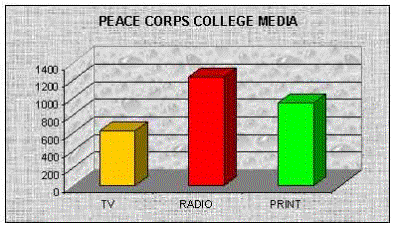
Print PSAs
In 1999 we worked closely with the Peace Corps to produce and distribute their first print PSA package, which was mailed to 7,000 newspapers and magazines. The campaign has generated nearly $725,000 in verified advertising support. via 1,058 print PSAs published in 371 magazines and newspapers, reaching just under 60 million people.
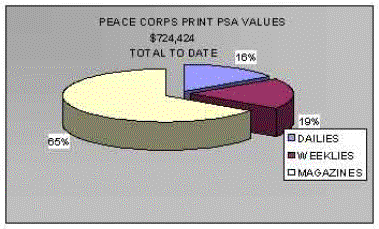
Packaging as a Strategy
It has long been our view as distributors that we are really not just in the PSA distribution business – we are in the direct mail business as well. And just as in all other direct mail work, it is imperative to use good design and copywriting techniques in PSA packaging. This helps us cut through the competitive clutter that exists at so many media outlets these days – particularly among broadcast television stations. As shown here, our typical TV PSA packaging concept consists of a colorful box label that is applied to heavy duty corrugated boxes into which the video tape is inserted. To communicate our “pitch” quickly and succinctly, we also include a four-color storyboard, which has several elements – a letter to the public service director, visual vignettes from the PSA itself, and facts on the client’s issue – all in one piece.

One of the challenges we faced with the print PSA component was that there were a wide variety of print ad executions in different sizes and focusing on different programs. The ads were designedDue to the large number of print executions, we recommended producing a bound “book” of print ads instead of distributing them loose-leaf. We believe that the excellent creative, our unique packaging concept and aggressive follow-up among the top 100 magazines, all contributed to the excellent success Peace Corps has enjoyed from its print PSAs.

Campaign Overview
The last Peace Corps campaign we distributed, “How Far Do You Want to Go?” was launched in February, 1999 and has generated just under $9 million in exposure, significantly above the norm. Of this amount, two-thirds of all exposure resulted from TV SIGMA data as shown here.
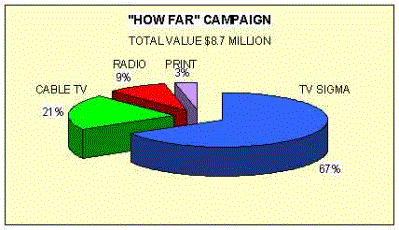
TV Shelf Life/Values
One of the very interesting and useful trends we learned as a result of having Nielsen SIGMA data is that the shelf life for PSAs is much longer than we could document using bounce-back cards.
To test the shelf life of this PSA – knowing we were not going to distribute another campaign for some time – we extended the SIGMA tracking to 12 months instead of the typical six-month tracking cycle. By extending the SIGMA tracking, values increased 83% and the number of airplays by two-thirds.
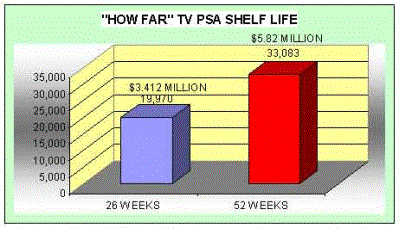
TV Usage by Daypart
Perhaps the second most widely held misperception about PSAs is that they air in “junk time when no one is watching TV.” Again, from all the campaign data we process month in and month out, there is a consistent use of TV PSAs during the better dayparts – from 7AM to 11PM. Typically half to sixty percent of all usage occurs during these dayparts. For the “How Far” campaign, about 51% of all PSAs aired during the better dayparts. While these may not be the times of day when young people are watching, it is a time when many “influencers” are watching TV and we know they will have much to say about the career choices of their sons, daughters and family members.

TV Benchmark Comparison
One of our evaluation techniques is to compare our client campaigns to benchmark averages taken from campaigns distributed to a similar number of media outlets. While no two campaigns are alike, the benchmark comparisons allow us to see how a particular campaign stacks up against others we distribute, and sometimes leads to other recommendations. This graph shows an eight campaign average for Peace Corps which far exceeds the typical PSA averages generated by other client campaigns.
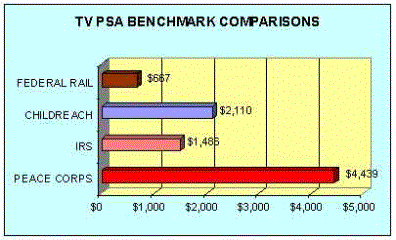
CABLEPAK
Peace Corps has participated in most of the CABLEPAK releases we have distributed since this shared-reel distribution service was launched in 1992. This technique has contributed a total of $8.5 million to overall values and has done so at a fraction of the cost of distributing individual dubs to stations. The benefit-to-cost ratio for CABLEPAK is 261-to-one and the Peace Corps average value for all releases is 26 percent above the average for all participants.
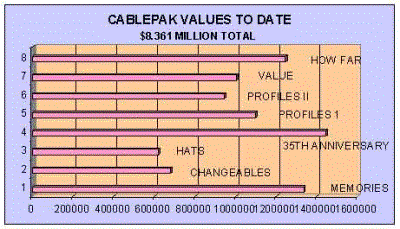
Top Market Penetration
Another qualitative measurement is to examine the number of markets where Peace Corps TV PSAs are airing. As shown here, just under two-thirds of the “How Far” TV PSAs aired in top 100 markets where is where 86 percent of U.S. TV households are located.

Radio Benchmark
While the Peace Corps radio dollar value exceeds our benchmark, they are being used in fewer markets and on fewer stations. Traditionally sub-par radio attainment is not necessarily a function of non usage, but non-reporting.
We know from follow-up techniques that many stations use a client’s PSA but do not take the time to complete and return the evaluation bounc-back card which is used to record usage. A low-cost technique we recommend for future Peace Corps radio PSAs is to send a reminder postcard to non-responding radio stations. In our experience this can significantly increase the dollar value of reported usage.

Importance of Local Marketing
One of the challenges that any organization faces when they implement a PSA campaign is how to connect with their internal audiences. This is critically important because local public affairs staff and outreach specialists are the key to successful PSA placement.
At the inception of our work for Peace Corps, we developed software for linking regional offices with the 30,000 media outlets in our master database. This linkage enables us to break out all PSA distribution lists and evaluation reports by each Peace Corps regional office. This, in turn, helps generate field support for the national campaign by involving regional public affairs specialists in campaign execution. Regional Public Affairs Specialists not only know where their PSAs were distributed; they know the rationale behind media selection, and they can easily see which media outlets in their community have, and have not, used Peace Corps PSAs previously. Because your role is so important to the success of the Peace Corps PSA program, we highly encourage you to become as knowledgeable as possible about how the PSAs are distributed, how and where they are being used, and where we need to make improvements. You should begin by reading the two articles on the Peace Corps Online website – “About On-Line Reports,” and “Placing PSAs in Your Community.” These articles tell you how our distributor develops distribution lists and your role in developing the distribution plan.
Using data from the last Peace Corps TV PSA campaign, we can demonstrate how important it is for both the national office and Regional Public Affiars specialists to keep current on PSA evaluation trends.
This graph depicts the number of TV PSAs sent to stations in each of the 11 Peace Corps regions. To some degree these numbers reflect a random disbursement of PSAs in that there is no attempt to concentrate PSAs in any particular market. The distribution plan is a function of how many media outlets there are in any given market and previous usage patterns.

The second graph shows the amount of total media exposure which was generated in each of the offices. And as you can see, there is a positive correlation between these two factors in many of the offices. However, the important point is that we have, to a large degree, maximized our targeting opportunities in these markets and the only way to increase exposure in the markets with below average attainment is to do a better job of local marketing.
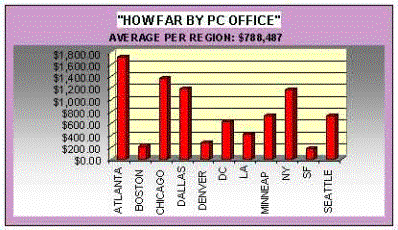
One of the most valuable aspects of the monthly reports that we generate for Peace Corps is the section showing values by regional office. It is very difficult to draw any meaningful conclusions about evaluation data when you are looking at trends from a national perspective.
When you break the data down by some geographic configuration, however, interesting trends can be spotted and tracked. In the case of the “How Far” campaign, it is clear from this graph there are a number of regions where significant improvement is needed.
Using Distribution and Evaluation Reports
To provide regional public affairs specialists with local intelligence data, we track usage (or non-usage) of all media outlets on the distribution list and display that data as well as a unique Previous Usage Index we have for all media outlets in our system. This information is then posted to the Peace Corps website as part of our Public Service Advertising GATEWAY website. This section of a distribution report shows how this data can be used to formulate a local media outreach plan.
Presenting this linkage between distribution and evaluation in this manner provides public affairs specialists with an action plan for follow-up and helps them provides the basis for making media follow-up contacts. From the national perspective, breaking evaluation reports out by Peace Corps regions also provides headquarters with intelligence data on areas of the country where PSA exposure is weak or non-existent.
Following is a sample of a Peace Corps distribution report for the Dallas Regional office. It clearly shows which stations have used Peace Corps PSAs and the previous usage index for the station. In those cases where there has been non-Peace Corps usage, but a high Previous Usage Index for the station, those stations definitely should be contacted.

On-Line Access
All the tools you need to do an effective local marketing job are on the Peace Corps Online website. You can see where PSAs were distributed; you can see where they are being used; you can share your intimate local market knowledge by changing future PSA distribution plans on-line; and you can order additional PSAs by using the on-line media contact form.
However, none of these tools will be meaningful unless they are used. As a Regional Public Affairs Specialist, you are the key to maintaining the excellent level of PSA exposure that the Peace Corps has enjoyed in the past decade.




